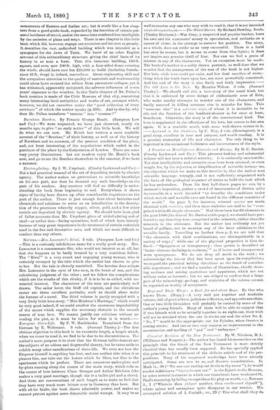CURRENT LITERATURE.
Eastern Cities and Italian Towns. By R. P. Pullen. (Stanford.) —The author of these brief notes of wanderings in Palestine, Egypt, and Italy gives us some chatty chapters about Jerusalem, Damascus, the Great Pyramid, Cairo, Etruria, Turin, Tivoli, and other oft- described places, towns, and territories. Mr. Pnllan's architectural knowledge makes him an interesting guide, but we cannot think that the republication in a Wok-form of these contributions to periodical literature will serve any useful purpose. A book mainly devoted to architecture, and yet wholly destitute of illustrations, is rather dull and difficult to understand, however simply it be written. Perhaps it may serve to interest young would-be travellers in some of the
monuments of Eastern and Italian art; but it reads like a few chap- ters from a good guide-book, expanded by the insertion of certain per- sonal incidents of travel, and at the same time rendered less intelligible by the omission of plans and maps. There is one chapter in this little book which did, however, engage our attention and interest us greatly. It describes the vast, unfinished building which was intended as a synagogue for the Jews of Turin. We know of no other English account of this extraordinary structure giving the chief facts of its history in so neat a form. That this immense building, 130 ft. square, and even now 240ft. high, with a four-sided dome covering the whole, should have cost but £24,000 to build (including founda- tions 45 ft. deep) is, indeed, marvellous. Great engineering skill and the scrupulous attention to the quality of materials and workmanship could alone have secured the edifice from premature collapse, yet it has withstood, apparently uninjured, the adverse influences of seven years' exposure to the weather. In this Turin chapter of Mr. Pullan's book mention is made of the Civic Museum of that city, containing many interesting local antiquities and works of art, amongst which, however, we did not ourselves notice the "good collection of ivory -carriages" of which the author speaks (p.203). And by-the-by, why does Mr. Pullen transform " tessera)" into " tessarte ?"



































 Previous page
Previous page